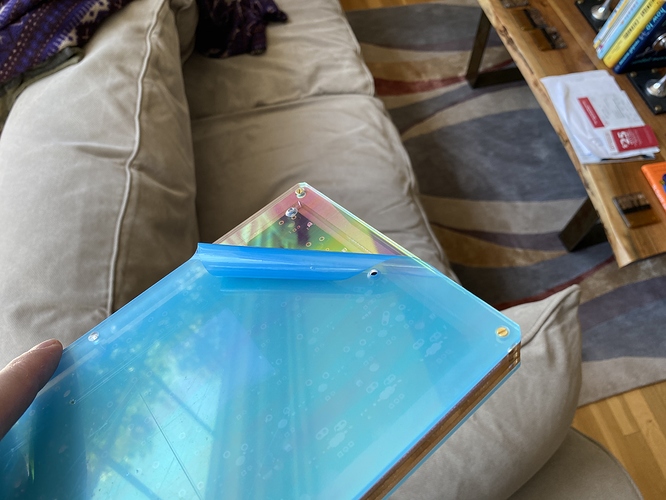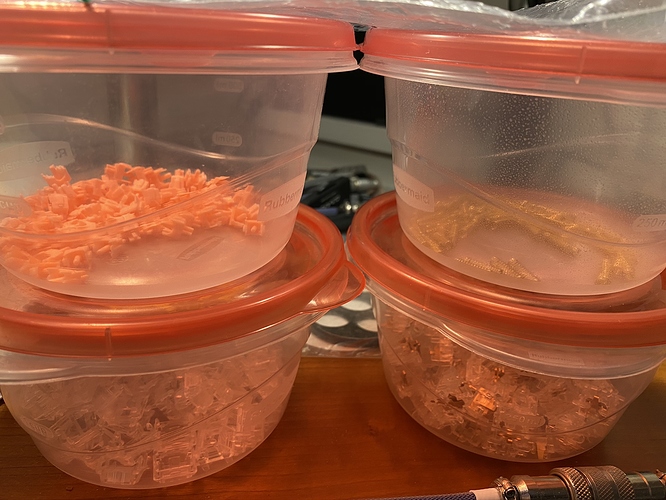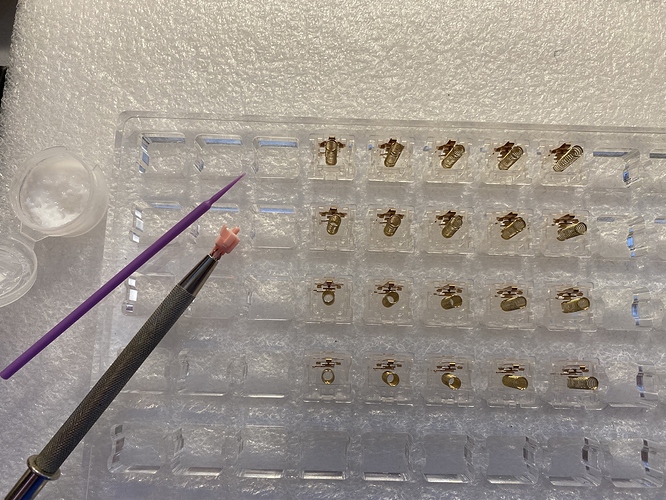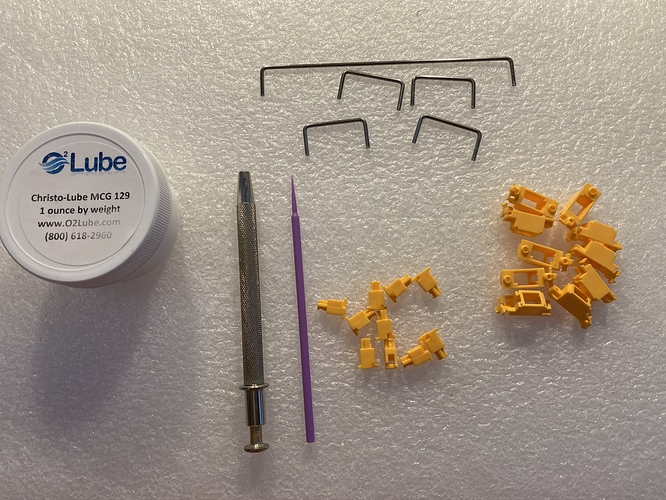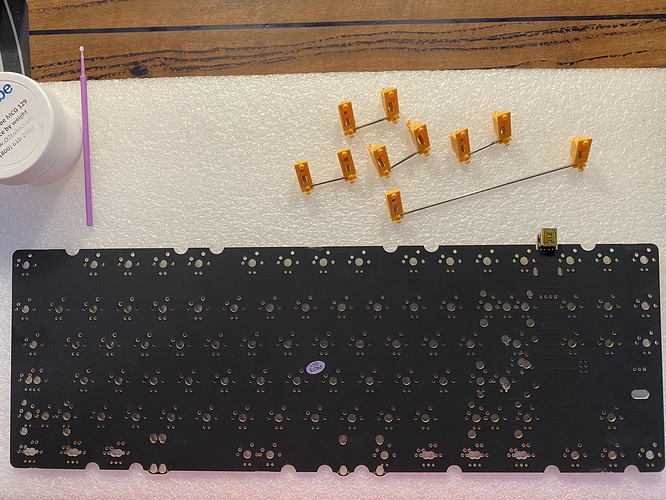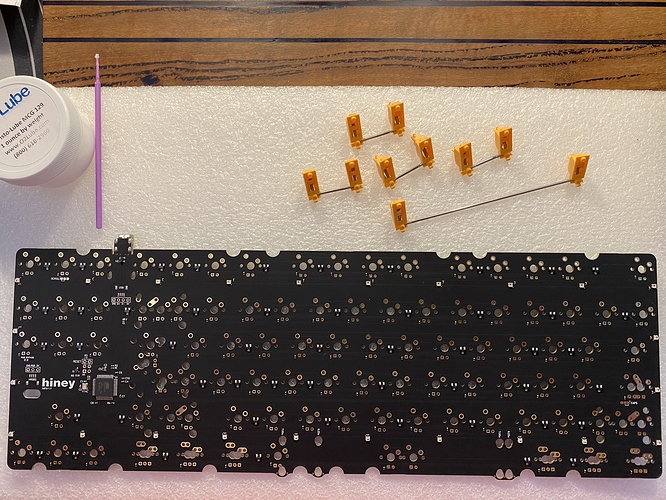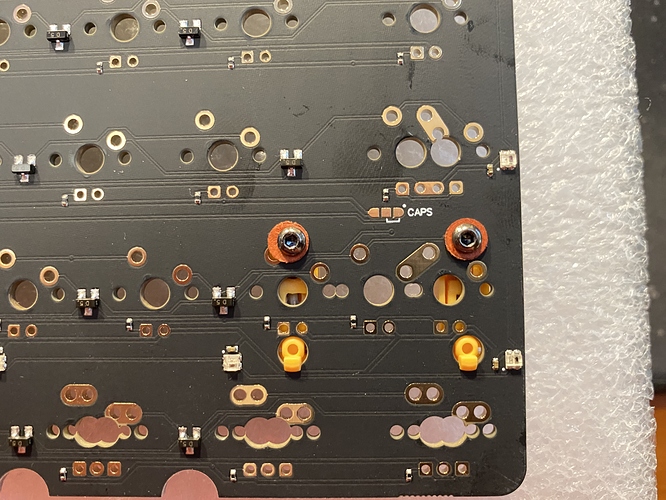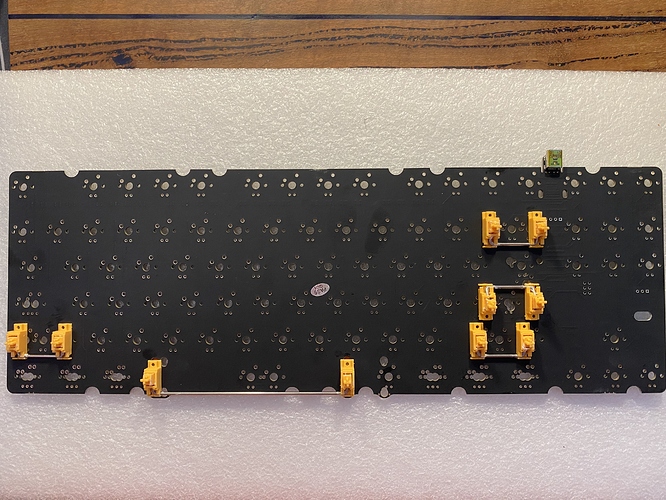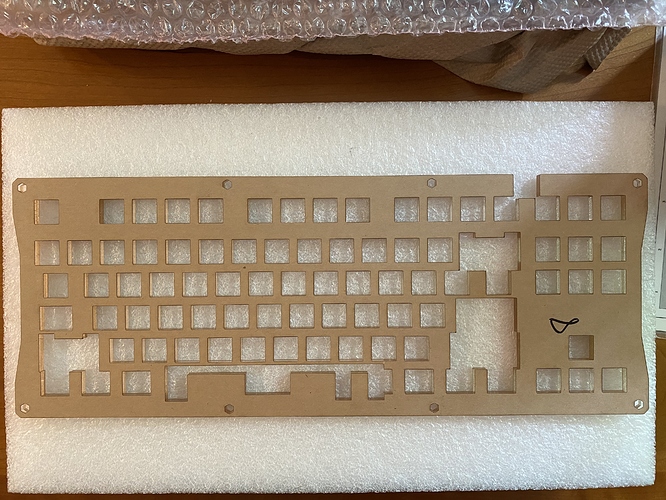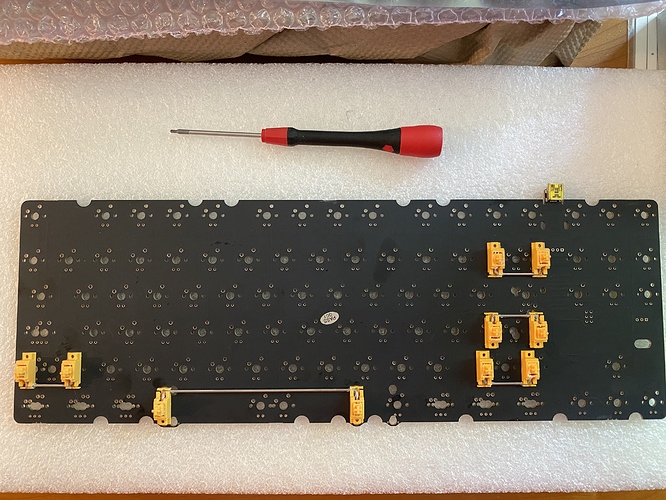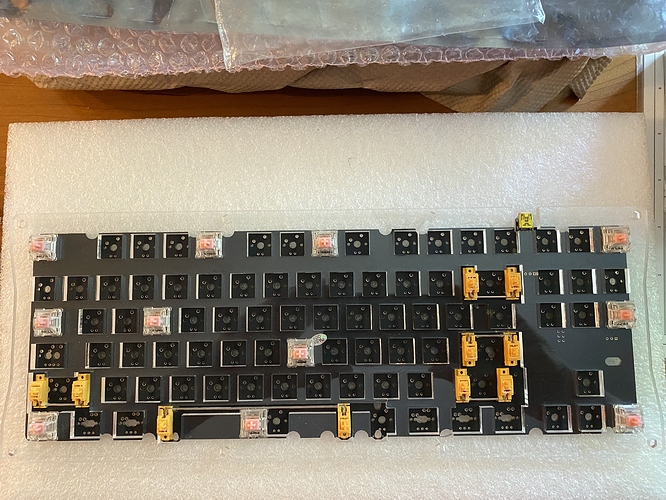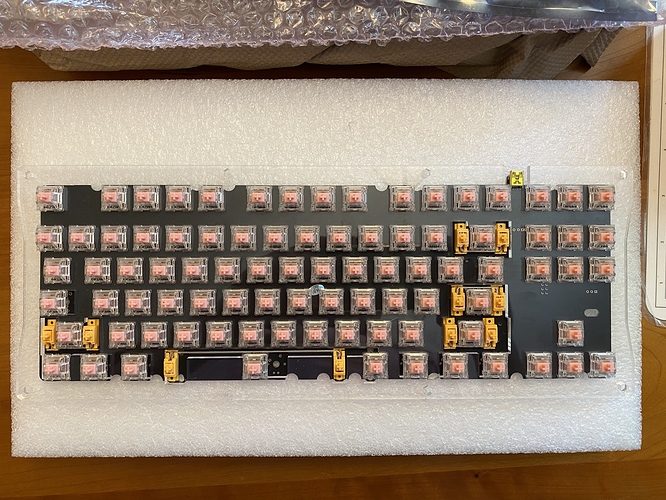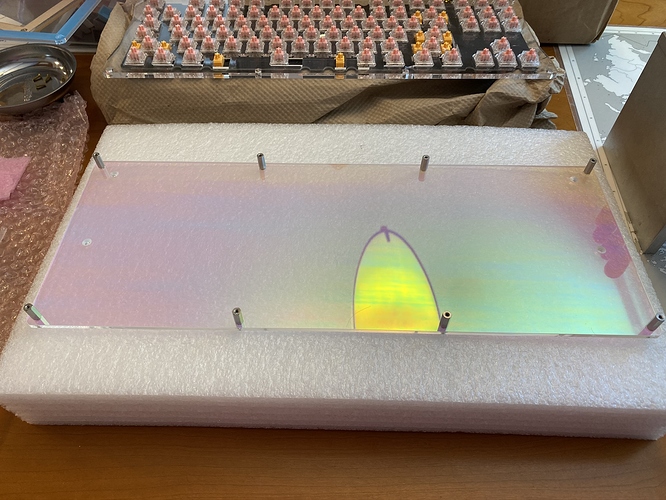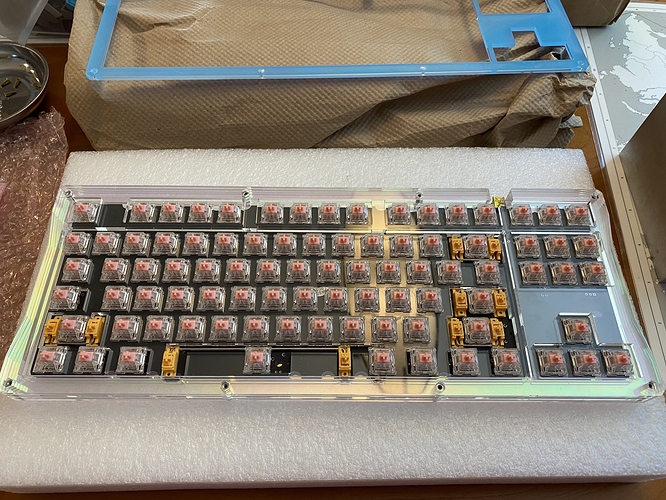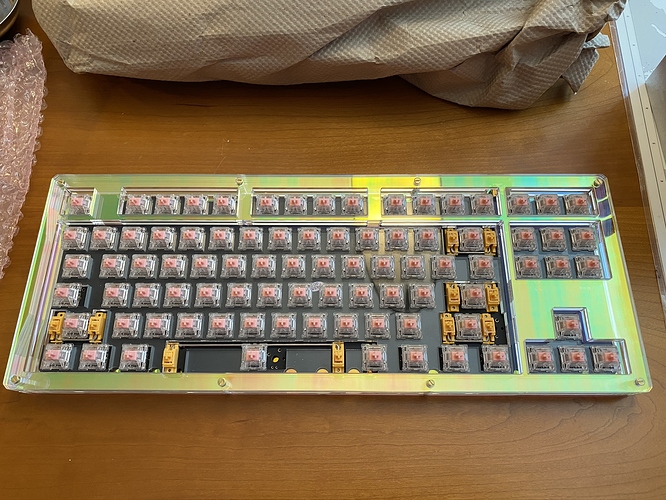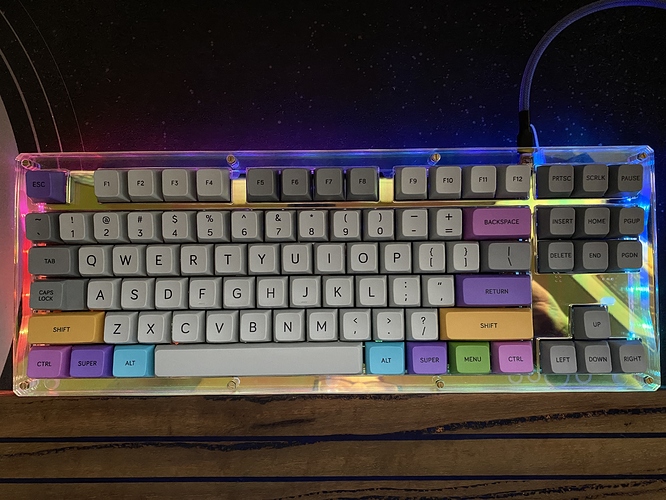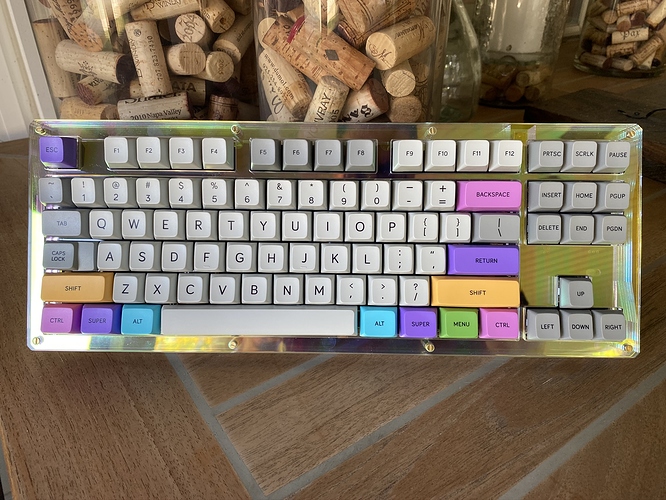Build #40: ElectroType 87
This client build began with a few requests:
- I’m a light typist, and even then, clack makes me crazy. Build me a keyboard as silent as you possibly can.
- This is not a wallflower keyboard. Give me colors.
- No tactiles. Bumps are for kids.
Ha! She had seen the acrylic tofu build I did some time ago, and really liked the MDA Big Bone set, so that solved the keycap portion of the equation. But what to use for the case? After some back-and-forth, it eventually occurred to me to show her a section of bifrost acrylic, acrylic with a different finish sometimes called a ‘mirror-like’ finish. While I wouldn’t call the result mirror-like, it does catch the light in interesting ways. Under direct lighting, it has almost a golden sheen, while under indirect lighting, particularly natural light from a window, prism-like rainbow effects are readily apparent.
Sold! The bifrost acrylic in question came as part of the ElectroType 87 kit, a TKL build from SwitchCouture. But before we get much further into that, we’ve got some switch and stab work to do.
The constraints of “silent”, “linear”, and “light”, intersected with my current collection of switches, yielded exactly one result: Sakurios. I used these back in Build #23, and found them to be quite pleasant to use. But at that time, I hadn’t graduated to Krytox GPL 205g0 for linears, which I suspect will yield an even quieter, smoother experience. This time around, I’ll do my usual spring tub lubing with 104, and then hit the stems with 205g0. Here we are post-tub lubing, pre-stem lubing.
As I’ve mentioned before, I like to lube switches in small batches, so I don’t go mad with the repetition. With 205g0 (well, really with any switch lube), I’ve been using dental applicators for a while now - I feel I have better control over lube application than I do with a brush, which means faster switch lubing.
For stabilizers, I went with Christo 129. This isn’t the obvious choice for a silent build, but I wanted to stay with stock switches, and given the 62g spring weights, I wanted to err on the side of responsive stabilized keys.
Ready for installation into the PCB, the h87a from Hineybush, which shipped with the ElectroType 87 kit. This is v1.7 of the h87a, which allows for north- or south-facing spacebars, something to consider before installing those spacebars!
Even if it’s not strictly necessary, these days I’m in the habit of installing cloth washers on the stabilizer screws, just as an extra precaution against PCB shorts. Regardless of what you may think about C3 stabs, it’s handy that they include the washers as part of their stabilizer kits.
All right, stabs in!
Quiz time. Here’s the acrylic plate (with protective backing still in place). What have I done wrong?
Yeah, I didn’t pay attention to spacebar orientation. Sigh. Fortunately, just a couple minutes of work with the screwdriver is all that’s needed. All right, stabs in again!
Next, we mount a few switches to get the alignment of the plate and PCB dialed in. Yes, I know some of you would have removed the “PASS QC1” sticker from the PCB, but I like to be visually reminded of Hiney’s love, as I’m sure my client will be.
All switches soldered and ready for action. Now is a good time to point out a nice feature of this acrylic build - the interior acrylic layers have cutaways on either side, which effectively creates board grips on both sides of the board when these layers are sandwiched between the rectangular top and bottom layers which don’t have the cutaways.
Also, note that the interior plate acrylic is clear, not bifrost - the interior layers of the ElectroType 87 kit are all clear acrylic.
The sandwich assembly starts with the bifrost base and eight hex nuts which are screwed into place from the underside. Although photos don’t do it justice, you can see the rainbow effect I mentioned earlier - my fingers aren’t purple, and the light over the table isn’t yellow-green…
As we stack the layers, it’s a good time to point out another appreciated feature of this sandwich build; the laser-cut holes for the bolts are hexagonal, not circular, which both facilitates alignment of the individual acrylic layers, and makes it easier to tighten the nuts when they can’t spin with your driver. Here we have the base and the three interior layers in place, with only the top layer missing.
With the top layer in place, we’re ready for keycaps.
Lessons learned
- Although I haven’t logged them yet, I’ve built a few Alice-style boards from laser-cut materials. Based on this experience, hexagonal bolts (and hole cutaways) would have been useful for all of those builds. The next time I have some sheets of plastic cut, I should modify the circular holes in the template to be hexagonal, and source hexagonal nuts and bolts.
- A truly silent mechanical keyboard is likely a contradiction - but this is certainly one of the quieter boards I’ve built. 205g0 on Sakurios is, as expected, very smooth and pleasant.
- I continue to enjoy MDA as a hypothetical and perhaps optimal point between the high profiles of SA and the flat expanses of XDA. If you dislike both SA and XDA, this might seem a bit like drinking a blend of two poisons for good health, but I’ll continue to argue that it’s worth a try if you’ve not yet done so.
- Bifrost acrylic brings its own kind of polarizing bling to the party - whether you like it or not is of course subjective, but it really does catch light in an interesting way.
- Before mounting stabs, check your plate for stab orientation. I feel like I learn this lesson about every ten builds or so, and promptly forget it every time. Part of me wonders if Hiney’s move to south-only spacebar wire on v1.8 of the h87a was because he’s as forgetful as I am…
You want color, we got color.
Specifications
case: ElectroType 87
- sandwich-style TKL
- bifrost (radiant) acrylic top and bottom layers
- clear acrylic interior layers
case dampening: n/a
PCB: h87a 1.7
plate: clear acrylic
plate/PCB dampening: n/a
stabilizers: C3 screw-in
- yellow, 1x6.25u, 4x2u
stabilizer mods:
- lubed with Christo-Lube MCG 129
- installed with cloth washers
switches: 87x 62g Sakurios
switch mods:
- springs tub-lubed with Krytox GPL 104
- stems hand-lubed with Krytox GPL 205g0
- no housing lube
keycaps: MDA Big Bone
HxWxD (without caps or feet): 0.75" x 14.5" x 5.5"
HxWxD (without caps): 1.13" x 14.5" x 5.5"
HxWxD: 1.38" x 14.5" x 5.5"
assembled weight: 0.95 kg (2.09 lb)
